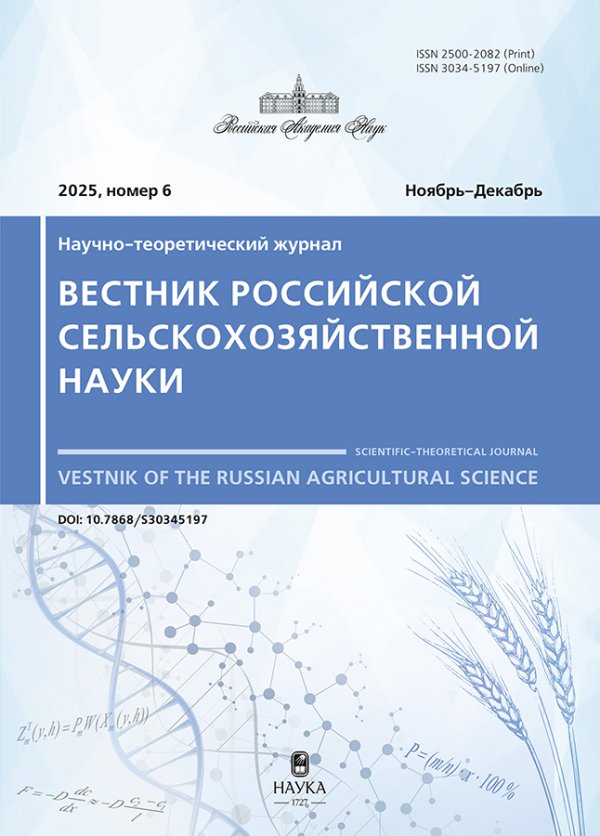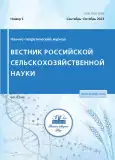Экологическое испытание новых сортов яровой тритикале в республике Марий Эл
- Авторы: Максимов В.А.1, Лапшин Ю.А.1, Золотарева Р.И.1
-
Учреждения:
- Марийский научно-исследовательский институт сельского хозяйства - филиал ФГБНУ «Федеральный аграрный научный центр Северо-Востока имени Н.В. Рудницкого»
- Выпуск: № 5 (2023)
- Страницы: 14-17
- Раздел: Статьи
- URL: https://journals.rcsi.science/2500-2082/article/view/233551
- DOI: https://doi.org/10.31857/2500-2082/2023/5/14-17
- EDN: https://elibrary.ru/XJOOIF
- ID: 233551
Цитировать
Полный текст
Аннотация
Ключевые слова
Об авторах
Владимир Алексеевич Максимов
Марийский научно-исследовательский институт сельского хозяйства - филиал ФГБНУ «Федеральный аграрный научный центр Северо-Востока имени Н.В. Рудницкого»
Email: maksimovvlad64@gmail.com
Юрий Алексеевич Лапшин
Марийский научно-исследовательский институт сельского хозяйства - филиал ФГБНУ «Федеральный аграрный научный центр Северо-Востока имени Н.В. Рудницкого»
Римма Ивановна Золотарева
Марийский научно-исследовательский институт сельского хозяйства - филиал ФГБНУ «Федеральный аграрный научный центр Северо-Востока имени Н.В. Рудницкого»
Список литературы
- Абделькави Р.Н.Ф. Сравнительная характеристика отдельных генотипов яровой тритикале по признакам урожайности и качества зерна // Мат. V Межд. науч.-практ. конф. "Методы и технологии в селекции растений и растениеводстве". Киров: ФАНЦ Северо-Востока, 2019. С. 3-6
- Асеева Т.А., Зенкина К.В. Экологическая устойчивость тритикале к неблагоприятным факторам окружающей среды // Юг России: экология, развитие. 2020. Т.15. №1. С. 49-59. doi: 10.18470/1992-1098-2020-1-49-59.
- Бирюков К.Н., Грабовец А.И., Крохмаль А.В. Некоторые аспекты технологии возделывания ярового тритикале на севере Ростовской области / Тритикале. Агротехника, технологии использования зерна и кормов. Мат. Межд. науч.-практ. конф. Тритикале и стабилизация производства зерна, кормов и продуктов их переработки". Ростов на Дону, 2016. С. 6-12.
- Доспехов Б.А. Методика полевого опыта с основами статистической обработки результатов исследований. М.: Альянс, 2011. 352 с.
- Зинченко В.Е., Кулыгин В.А., Гринько А.В., Вошедский Н.Н. Влияние приемов возделывания на урожайность яровой тритикале в условиях обыкновенных черноземов / Научный журнал Российского НИИ проблем мелиорации. № 4(32). 2018. С. 250-265. doi: 10.31774/2222-1816-2018-4-250-265.
- Ковтуненко В.Я., Панченко В.В., Калмыш А.П. Новый сорт яровой тритикале Савва / Мат. V межд. науч.-практ. конф. "Методы и технологии в селекции растений и растениеводстве". Киров: ФАНЦ Северо-Востока, 2019. С. 81-84.
- Кокурин Т.П., Прохорова Н.Н. Методические указания по расчету экономической эффективности использования в сельском хозяйстве результатов научно-исследовательских работ для условий Северо-Востока европейской части РФ // СВ НМЦ РАСХН, типография НИИСХ Северо-Востока им. Н.В. Рудницкого, Киров, 2008. 65с.
- Лапшин Ю.А., Новоселов С.И., Данилов А.В. Влияние минеральных удобрений на продуктивность ярового тритикале в условиях Республики Марий Эл / Известия Санкт-Петербургского государственного аграрного университета. 2019. № 3(56). С. 74-81. Режим доступа: https://doi.org/10.24411/2078-1318-2019-13074.
- Лапшин Ю.А., Максимов В.А., Золотарева Р.И. Влияние агроклиматических условий и минеральных удобрений на зерновую продуктивность ярового тритикале в условиях Республики Марий Эл / Аграрная наука Евро-Северо-Востока. 2022; 23(3):307-317. DOI: https:/doi.org/10.30766/2072-9081.2022.23.3.307-317.
- Методика государственного сортоиспытания сельскохозяйственных культур. М.: Колос, 1985. Вып. 1,2. 267 с.
- Тысленко А.М., Скатова С.Е., Зуев Д.В., Лачин А.Г. Итоги селекции ярового тритикале в Верхневолжском федеральном аграрном научном центре / Научно-производственный журнал "Зерновые и крупяные культуры. №2(34). 2020. С. 90-95. doi: 10.24411/2309-348Х-2020-11175.
- Федюшкин А.В., Пасько С.В., Парамонов В.А. Развитие растений ярового тритикале в зависимости от предшественника и доз азотных удобрений // Тритикале: мат. Межд. науч.-практ. конф. "Тритикале и стабилизация производства зерна, кормов и продуктов их переработки". Ростов на Дону, 2018. С. 209-216.
- Федюшкин А.В., Пасько С.В. Развитие растений ярового тритикале в зависимости от предшественника и азотных удобрений / International Jornal of Humanities and Sciences. Vol. 8 (47). 2020. С. 73-77.
- Wysokkinski A., Kuziemska B. The sources of nitrogen for yellow lupine and spring triticale in their intercropping. Plant Soil Environ. 2019. 65: 145-151.
Дополнительные файлы










